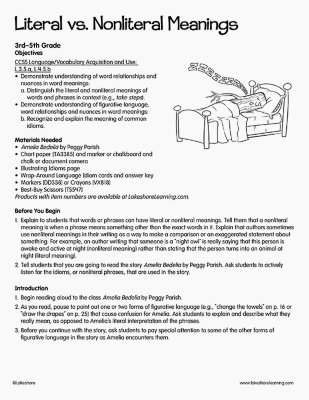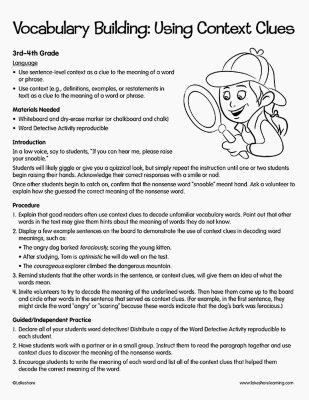Narrow by Grade
- Infant (0)
- Toddler (0)
- Preschool (0)
- Pre-K (0)
- Kindergarten (0)
- 1st (0)
- 2nd (0)
- 3rd (3)
- 4th (3)
- 5th (0)
- 6th & Up (0)
Grade
Narrow by Age
- 0-18m (4)
- 18-36m (4)
- 3 yrs. (0)
- 4 yrs. (5)
- 5 yrs. (5)
- 6 yrs. (5)
- 7 yrs. (2)
- 8 yrs. (4)
- 9 yrs. (3)
- 10 yrs. (2)
- 11 yrs. & Up (0)
Age 9 yrs.
3 results for "daily language journal"
Filters
Clear All
Literal vs. Nonliteral Meanings
3rd Grade - 4th Grade
Objective CCSS Language/Vocabulary Acquisition and Use: L.3.5.a, L.4.5.b Demonstrate understanding of word relationships and nuances in word meanings: a. Distinguish the literal and nonliteral meanings of words and phrases in context (e.g., take steps). Demonstrate understanding of figurative language, word relationships and nuances in word meanings: b. Recognize and explain the meaning of common idioms. Materials Needed Amelia Bedelia by Peggy Parish Chart paper and marker or chalkboard and chalk or document camera Illustrating Idioms page Wrap-Around Language Idiom cards and answer key Markers or Crayons Best-Buy Scissors Before You Begin Explain to students that words or phrases can have literal or nonliteral meanings. Tell them that a nonliteral meaning is when a phrase means something other than the exact words in it. Explain that authors sometimes use nonliteral meanings in their writing as a way to make a comparison or an exaggerated statement about something. For example, an author writing that someone is a “night owl” is really saying that this person is awake and active at night (nonliteral meaning) rather than stating that the person turns into an animal at night (literal meaning). Tell students that you are going to read the story Amelia Bedelia by Peggy Parish. Ask students to actively listen for the idioms, or nonliteral phrases, that are used in the story. Introduction Begin reading aloud to the class Amelia Bedelia by Peggy Parish. As you read, pause to point out one or two forms of figurative language (e.g., “change the towels” on p. 16 or “draw the drapes” on p. 25) that cause confusion for Amelia. Ask students to explain and describe what they really mean, as opposed to Amelia’s literal interpretation of the phrases. Before you continue with the story, ask students to pay special attention to some of the other forms of figurative language in the story as Amelia encounters them.
View Lesson PlanCause and Effect
3rd Grade - 4th Grade
Objective CCSS Reading: Informational Text RI.3.3: Describe the relationship between a series of historical events, scientific ideas or concepts, or steps in technical procedures in a text, using language that pertains to time, sequence, and cause/effect. Materials Needed “The Earthquake that Changed Earth” nonfiction reading selection “The Earthquake that Changed Earth” graphic organizer and sample graphic organizer Cause & Effect Flip Book template Scissors Pencils or markers A copy of any other nonfiction text
View Lesson PlanVocabulary Building: Using Context Clues
3rd Grade - 4th Grade
Objectives Language Use sentence-level context as a clue to the meaning of a word or phrase. Use context (e.g., definitions, examples, or restatements in text) as a clue to the meaning of a word or phrase. Materials Needed Whiteboard and dry-erase marker (or chalkboard and chalk) Word Detective Activity reproducible Introduction In a low voice, say to students, “If you can hear me, please raise your snooble.” Students will likely giggle or give you a quizzical look, but simply repeat the instruction until one or two students begin raising their hands. Acknowledge their correct responses with a smile or nod. Once other students begin to catch on, confirm that the nonsense word “snooble” meant hand. Ask a volunteer to explain how she guessed the correct meaning of the nonsense word.
View Lesson Plan

